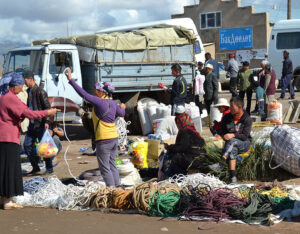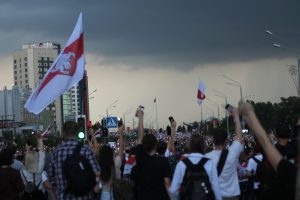Kyrgyzstan: Balancing on the Verge of Stability

Download “Kyrgyzstan: Balancing on the Verge of Stability”
EUCAM-Policy-Brief-19.pdf – Downloaded 390 times – 662.99 KBIntroduction
In Kyrgyzstan the risk of instability remains. The country practices genuine elections and power-sharing, is open to international engagement, and promotes basic rights such as free speech. In 2010 Kyrgyzstan adopted a new Constitution, moving away from a super-presidential model to a system in which the president and the parliament share power more equally. Its economic performance is positive: the IMF assessed that the economy recovered quickly due to improved security and political stability, better-than-expected agricultural performance and a timely fiscal stimulus.(1) However, it is the only ex-Soviet state to undergo two turbulent regime changes – the so called ‘Tulip-1’and ‘Tulip-2’ revolutions of 2005 and 2010 – and is affected by a strong regional split between the North and the South, one of the factors behind both ‘revolutions’. This makes Kyrgyzstan a country of paradoxes where it mixes positive developments with severe threats to its stability.
The country is split geographically into the North and the South, each with a distinct identity. The first president, Akayev (until 2005), was from the North, and after his removal power shifted to the South, where Kurmanbek Bakiyev originated from (until April 2010). The current government, led by President Roza Otunbayeva and Prime Minister Almazbek Atambayev, are perceived as ‘northerners.’ The South is home to an Uzbek minority who make up about 15 per cent of the country’s population, whereas the Kyrgyz constitute 70 per cent.
The Osh province in the South is 68 per cent Kyrgyz and 28 per cent Uzbek. Osh city, the southern capital, contains 47 per cent Kyrgyz and 44 per cent Uzbek residents. There are sizeable Uzbek communities in the Jalalabad and Batken provinces too.
In June 2010 Kyrgyzstan was the scene of interethnic clashes between Kyrgyz and Uzbeks. Ethno-nationalism is a central challenge for the country. While before the June clashes this issue was stronger in the South, the events of June gave it a fresh impetus and served to unite the northern and southern Kyrgyz behind the same cause.
This policy brief looks at where Kyrgyzstan now stands, between interethnic conflict and the forthcoming presidential elections on 30 October 2011. Possible scenarios range from the establishment of the first functioning democracy in Central Asia to renewed internal strife, though the most likely outcome remains a continued balancing act on the verge of instability. State resilience to pressure remains low. Internal factors, e.g. regionalism and ethno-nationalism, could shape the country’s future. At the same time, the role the international community is becoming secondary, as its influence is fading.
The first part of this brief provides an overview of the situation in the South, while the second part deals with the domestic and international inquiries into the June 2010 violence and the impact of the latter. In part three the developments in the run-up to the presidential elections are outlined including an assessment of the candidates likely to compete. The brief concludes with an analysis of the country’s prospects and what European actors can expect in their future interactions in Kyrgyzstan.
The situation in the South
On 10 June Kyrgyzstan commemorated the first anniversary of the 2010 interethnic violence between the Kyrgyz and Uzbek communities in the South, in which about 470 people died, 1,900 people were injured and more than 400,000 displaced internally or fled into Uzbekistan. It also marks 21 years since the previous clashes, the dates of which (4-8 June 1990) almost coincide. The two conflicts had similar causes: the rise of ethno-nationalism on both sides; the weakening of political authority; an atmosphere of openness which allowed for demands to be voiced, and a sense of an historical opportunity to make gains, which previously seemed impossible. Thus, it is important to understand how central the June clashes in the South are to the political trajectory of Kyrgyzstan.
One year on, the situation has somewhat stabilised. There are modest improvements in the spheres of human rights and law enforcement. Relations between the Kyrgyz majority and Uzbek minority remain tense, although some Uzbek-owned businesses operate and the rehabilitation of destroyed housing is progressing. Full-scale organised riots are unlikely in the short term as both communities have too much at stake to allow their anger to prevail. The concern is that hostilities may flare up sporadically, as last year’s clashes broke a taboo on the use of violence. Communities are psychologically ready to respond with force if they feel threatened.
Three factors are important for an understanding of the situation in the South. One is mutual fear. The Kyrgyz, although appearing triumphant on the surface, are afraid that the Uzbeks may harbour separatist intentions, which could undermine Kyrgyzstan’s statehood, may desire revenge for the harm they suffered, and may have support from abroad. They fear that if things flare up again, the President of Uzbekistan, Islam Karimov, may not be as cautious next time and Uzbekistan could retaliate. The Uzbeks are apprehensive that they are powerless vis-à-vis the police and prosecutors, and defenceless against harassment by Kyrgyz youth. Security and law-enforcement is largely in the hands of the Kyrgyz, who favour their ethnic kin. From their perspective, if the authority of the state weakens and a security gap(2) opens again, the community would find itself in an extremely vulnerable position.
Secondly, there is a lack of a serious reconciliation process. The exodus of Uzbek leaders left the community ‘beheaded.’ There are almost no Uzbek authority figures to participate in well-intended peace-building initiatives. Reopened prosecution cases against exiled Uzbeks in 2011(3) ruled out the possibility that some of them would be able to return quietly. Thus, the authorities have few interlocutors.
Lastly, the writ of the central government over the South is weak. It is seen as northern and alien, and the South remains a law unto itself. In Osh, power is not consolidated and different forces overlap: that of Mayor Melis Myrzakhmatov, whose office is not subordinate to the Osh provincial governor due the special status of Osh city, the governor, the deputy prime minister responsible for reconstruction in the South, and representatives of central security agencies who report directly to Bishkek. Absence of a ‘power vertical’ in these volatile conditions makes it difficult for the centre to pursue a single course.
Stability and development in the South are undermined by intercommunal tensions, criminality and its impact on the security sector, and by the exodus of Uzbeks and other minorities, mostly to Russia. Nationalism runs unabated and dominates social relations; those Uzbeks who wish to stay have to maintain a low profile.
In the South the de facto policy which is being implemented in respect to the Russian language weakens its position in official use, such as the use of Russian for documents and formal correspondence. This does not make it difficult for the Uzbek minority to communicate with the Kyrgyz because the languages are mutually intelligible, when there is enough goodwill to do so, but is aimed at (1) giving those Kyrgyz who went to Russianlanguage schools and universities and are not comfortable with written Kyrgyz a message that they should master it; (2) making the cost of doing business prohibitive for minorities, as they would be forced to hire additional labour to translate all documents into Kyrgyz; and (3) elevating the status of Kyrgyz over Russian, which serves as an expression of ‘Kyrgyz statehood,’ the supremacy of the ‘titular nation’ and a manifestation of ethno- nationalism.(4) Intensive promotion of Kyrgyz, together with a tense and divisive atmosphere in society, pushes those who feel they can start a life elsewhere to leave.
While an exodus of minorities would create a more ethnically homogenous society, it could undermine economic prospects. Before the conflict, Uzbeks had benefited from market reforms under Akayev which enabled small and medium enterprises to develop. They occupied business niches which flourished, and constituted the backbone of an enterprising middle class in the south. Now harassment, racketeering and asset raiding is forcing business people to try their luck elsewhere.
Investigations and recriminations
The international community advocated for an independent investigation into the June 2010 violence but was reticent to supply it with a mandate. The UN was slow to react to the crisis, and its contribution to the Kyrgyzstan Inquiry Commission (KIC) was to provide guidance on its Terms of Reference. The OSCE, chaired by neighbouring Kazakhstan and running into controversy over a Police Advisory mission to Kyrgyzstan,(5) did not want to take on another contentious task. The authorities in Kyrgyzstan favoured an EU mandate as was the case in 2008 concerning the South Ossetia Tagliavini inquiry, which they were led to believe the Kyrgyzstan inquiry would be modelled on. The EU did not take it up either because the Union was not politically involved the way it had been in Georgia through previous Medvedev-Sarkozy negotiations, and it would take too much time to convince all 27 members states that Kyrgyzstan mattered.(6) Eventually, the Office of War Crimes Issues of the US State Department came to play a major role at the KIC.
The resultant commission was chaired by Dr. Kimmo Kiljunen, a Finnish parliamentarian and OSCE Parliamentary Assembly Special Representative for Central Asia at the time, and was mandated by Kyrgyzstan’s president, Roza Otunbayeva. It consisted of seven members nominated by states and international organisations, but acting in their individual capacities, and was supported by international organisations and donor governments. The inquiry was an unprecedented step in Central Asia. The Commission released its report on 3 May in Bishkek after the most damaging parts were leaked by Kyrgyzstan’s news agency 24.kg. The KIC Report(7) largely follows the line taken by Human Rights Watch(8) and International Crisis Group(9) reports by stressing the failure of the state to protect its citizens, but goes further in qualifying the state’s actions as crimes against humanity.
KIC recommendations fall into two categories: accountability and reconciliation. The former urges the state to ‘conduct thorough, independent and impartial investigations into crimes, without reference to the ethnicity of alleged perpetrators, and ensure that prosecutions conform to international fair trial standards.’(10) It recommended incorporating crimes against humanity into the Criminal Code. Reconciliation calls for a commitment to a multiethnic state rather than one built around the supremacy of the ‘titular nation.’ KIC advocates greater inclusion, cultural recognition and state policies that ensure genuine equality for all citizens.
The report was met with enthusiastic support from the US State Department, which was one of its principle backers, who expressed hope that ‘the Government will take further steps to ensure accountability and justice,’(11) and the UN Office of Human Rights. The EU High Representative for Foreign Affairs and Security Policy, Catherine Ashton, issued a statement calling upon the authorities to implement the recommendations,(12) and the OSCE Parliamentary Assembly highlighted the authorities’ transparency in dealing with the Commission.(13) Russia’s Foreign Ministry spokesman noted that ‘the conclusions seem generally balanced.’(14)
The President and the government accepted some criticism, mainly in the field of rule of law, but rejected the qualification of the violence as crimes against humanity. They considered the Report biased, portraying one side exclusively as victims and the other as perpetrators.(15) Bishkek’s stance was that rather than being a step towards reconciliation, the Report may have a provocative effect. Deputy Prime Minister Jantoro Sadybaldiev warned that the Report may instigate further interethnic clashes.(16) The response from parliamentarians was harsher: all but one elected representative refused to recognise the legitimacy of the Commission and the conclusions of the Report, which in their view had no status in domestic or international law, declared Kimmo Kiljunen persona non grata, and threatened to prosecute those who supplied the KIC with information.
The Report generated a passionate domestic debate. Some expressed satisfaction that the government’s actions were condemned. Others considered that with so many actors, including -Uzbek leaders, having contributed to the tragic spiral of events over the years, it is unfair to attribute sole blame to those who happened to be in the job at the time. Consensus lies around the issues which touch upon notions of identity and culture, and underscore the insecurity of Kyrgyz statehood, still new and fragile, vis-à-vis a larger Uzbek nation with its developed material culture and long urban tradition.
The idea to consider restoring the previous name ‘Republic of Kyrgyzstan’ instead of ‘Kyrgyz Republic’(17) as less ethnically charged was universally rebuffed. The suggestion to allow the use of the Uzbek language at the local level for forms and documentation was presented as giving it an official status and vehemently discarded. The emotional response was triggered by what was regarded as inflammatory language, especially in the Russian version of the Report,(18) lengthy descriptions of sexual violence, shocking in a socially conservative society, and the suggestion that Uzbeks were the traditional population of the South, implying that the Kyrgyz were newcomers.
Such reactions reflect the nation’s feelings of being ostracised, which can turn dangerous, as it reinforces an anti-outsider sentiment and a sense of having nothing to fall back upon but ethnic solidarity. The Kyrgyz are now at a point where they feel that the suffering of their community has not been acknowledged and examples of cross-ethnic solidarity, when Kyrgyz people risked their lives to save members of the Uzbek community, have been ignored. The KIC Report became an outlet for venting frustrations. Support came only from Uzbek diaspora organisations, but the Uzbek community in Kyrgyzstan was unable to publicly express their views.
The Kyrgyz and the international community are at odds on how to move forward. While Navi Pillay, the UN High Commissioner for Human Rights, believes that the Report marks only the start, urging the government to follow up with the establishment of individual criminal responsibility,(19) the Kyrgyz public believes that it is time to stop listening to foreign actors. It is unclear who would take up the responsibility for the mitigation of the post-KIC fallout. The Commission finished its work and is no longer involved in the country. Their recommendations have little chance to be implemented, as national stakeholders are not a receptive audience. Some among the international community question whether the KIC Report facilitates or complicates peace-building efforts by outsiders, who are no longer perceived as impartial. After the KIC hearings parliament set up a commission to investigate who was responsible for allowing the OSCE Police mission to operate in-country.
Kyrgyz politicians are disinclined to let the events rest. Three domestic commissions issued their reports on the June clashes. The first by Ombudsmen Tursunbek Akun was published in December 2010 and attributed the blame solely to Uzbek leaders. The second, a National Commission set up by the President, qualified the events as ‘interethnic conflict.’ It admitted that the lessons of 1990 had not been learnt, as Uzbeks remained underrepresented at the higher echelons of power and in law-enforcement. The National Commission concluded that violence was organised in advance, and that several Uzbek leaders, the Bakiyevs’ clan and foreign religious extremists had a hand in it. It reprimanded the government for its lack of foresight and weak response to the crisis, and was bold enough to name names of existing power holders whose actions were recommended for further investigation. The value of the Report is in forward-looking strategy on interethnic relations.
The third commission was set up in December 2010 by parliament at the behest of the opposition, on Ata-Jurt’s initiative, as a move against the politicians who had formed the Provisional Government (PG) during June’s events. Its focus is the establishment of individual responsibility and prosecution. In June 2011 the Commission presented three different versions as the deputies could not reconcile their differences. The majority report calls for the prosecution of most of the senior figures among civilian and security office-holders who dealt with the crisis at the time. Parliamentarians blamed the President and her ministers for allying with Uzbek leaders and letting them escape after the events of June.
In this debate, President Otunbayeva found herself between a rock and a hard place. The KIC placed the blame on the government she led and on her personally, only marginally taking into account mismanagement of interethnic relations in the Akayev and Bakiyev periods. At the same time, she came under heavy criticism from domestic politicians for inviting the KIC in the first place.(20) The KIC and Parliamentary Reports provide handy ammunition for the contenders in the forthcoming presidential elections.(21)
This individual politician’s fate represents an existential choice facing the whole country. With Otunbayeva’s term expiring at the end of the year, and a new president taking office, the question is how she will go down in history. Will she be remembered as the first female CIS head of state, who brought the country towards genuine elections and democracy, or will her legacy be interethnic violence and crimes against humanity? Will she, akin to Mikhail Gorbachev, be favoured more internationally than nationally?
Towards Presidential Elections
After the adoption of the new Constitution, Kyrgyzstan’s political system has become complex. Five parties are represented in the parliament, elected in October 2010, but none has a clear majority. After two months of horse-trading, the premiership went to the Social Democrats, seen as a northern party, and the position of the speaker, to the Ata-Jurt, who have a southern base. So far the new parliament has not been a model of effective governance, arguing about the division of power and assets. Its main preoccupation is the presidential election, which would decide the question of power, presently dispersed across various actors and institutions.
The open character of Kyrgyzstani politics makes the run-up to the election more turbulent and less predictable. The race is likely to deepen the North-South divide. One of the front-runners is Almazbek Atambayev, prime minister and leader of the Social Democrats, who comes from the north. He may become the single candidate of the parties which constituted the Provisional Government during the June 2010 clashes. These politicians hope to avoid any prosecution for the 2010 violence, which victory of a southern candidate would surely unleash. The other northern candidate is Felix Kulov of Ar-Namys, a Soviet-era politician and the only one standing for a multiethnic society. He can count on the minority vote, as was the case in the parliamentary elections, and be a unifying figure nationally, but he does not appear to have strong support.
The two Southern candidates are Ata-Jurt’s leader Kamchybek Tashiyev and the charismatic Adakhan Madumarov of Butun Kyrgyzstan. Both are renowned nationalists, are in tune with the mood of the country and enjoy widespread popularity.
Kyrgyzstan’s politics are deeply fragmented, with politicians maintaining their regional strongholds as power bases. The lack of a coherent political class and competing patronage networks organised on a geographical basis has stalled development.
Political actors have few restraints and do not hesitate to bring their disputes into the open, as the 1 April fistfight in Parliament between MPs Altynbek Sulaimanov and Kamchybek Tashiyev demonstrated. There is a danger that electoral battles could turn violent, and lead to further polarisation among regional groupings if the losers refuse to accept defeat. The ‘Revolution’ may not be over: intra-Kyrgyz political struggles to achieve national consolidation still lie ahead.(22) At the same time, behind the scenes there is greater alignment within the political elite. Often bitter opponents in public are capable of negotiating and reaching compromise in private. Still, horizontal alliances are not formed around issues, but are products of elite bargains between key personalities.
Two recent popular uprisings have led experts to question whether this will become a ‘normal pattern’ for Kyrgyz politics. Kyrgyzstan remains a fragile state but is unlikely to experience a ‘Tulip-3’ revolution. The government structures may be weak, but as long as they are not oppressive, people go along with them, as their expectations on state performance are fairly low. However, the institutions – the presidency, the government and Parliament – are too fluid to conclude with any certainty whether Kyrgyzstan is on the road to democracy or not. Forces of ethno-nationalism may well come to power through democratic means, but what they will do with it is unknown.
Outlook for External Powers
In the meantime, instability in Kyrgyzstan is a concern for its neighbours. Cross-border incidents along the Uzbek-Kyrgyz and Tajik-Kyrgyz borders intensified in 2011 over transit, land use and the actions of border guards. None escalated into significant violence but relations remain tense. In the aftermath of the June violence the authorities in Kazakhstan, a state related to the Kyrgyz by kinship, were apprehensive over potential problems between ethnic Kazakhs and its own Uzbek minority, which is concentrated in the province of Southern Kazakhstan on the border with the Tashkent province of Uzbekistan.
The international community’s inaction in June 2010 was not commendable, events moved faster than external actors could react. As clashes broke out, foreign officials were primarily concerned with the evacuation of their own citizens from the South(23) rather than helping the government stabilise the situation. In its response to the KIC Report the government stressed that it had not received any assistance from the international community during the clashes, despite the main task of international organisations being to react to such problems. This is hard to argue against: Kyrgyzstan is a case of international neglect and unwillingness to shoulder responsibility for crisis management. In an event of further upheavals, would the international community do any better?
Thus far, Kyrgyzstan is the Central Asian country most open for engagement and willing to listen to external advice. Post-KIC fallout may turn this into a thing of the past. The current President is well aware of the importance of maintaining international cooperation, but is also conscious of the price she has to pay for it internally. International actors, such as the EU, European states, OSCE and NATO, have to be realistic that the window of opportunity to influence events in Kyrgyzstan may be closing. Europe may have to accept that its advice, especially in the area of rule of law, is unlikely to meet with appreciative interlocutors after Otunbayeva leaves office. It may be more realistic to target sectors with Kyrgyz partners open to negotiation, rather than coming with an ambitious reform agenda.
Instead, Europe is best advised to take a sober look into why its substantial aid to the security sector and for programmes aimed at conflict prevention has yielded minimal results. One reason is that Kyrgyzstan has a low capacity to absorb international aid. However, the rise of ethno-nationalism has also been overlooked. Before the EU and other European actors embark on new assistance programmes, they need to conduct a comprehensive and honest review of their previous efforts in conflict prevention, early warning and assistance to the security sector in Kyrgyzstan. In future, donor programmes should lead by example and make multiethnic recruitment a requirement in the projects they sponsor and proactively seek cadre from minority groups. As Kyrgyzstan successfully mainstreamed gender, it should be encouraged to do so with regards to minorities, starting with donors’ own operations in the country.
Conclusion
Although a renewal of mass violence is not expected, state resilience remains low. Kyrgyzstan is vulnerable to cross-border tensions, problems with minorities and strained North-South relations caused by a deep regional divide. Cleavages in society make a return to authoritarian rule unlikely but conducting the business of governing the country in a democratic way is not easy either, given social fragmentation. One unifying factor among the Kyrgyz majority is the force of ethno-nationalism, reinforced by the inter-ethnic clashes in the South and stoked again by the KIC verdict. Although it strengthens solidarity among different Kyrgyz groups from the North and the South, this largely happens at the minorities’ expense, as they are losing ground. The ethnonationalist discourse also prevents the political class from calming social tensions and works to maintain an emotionallycharged atmosphere in the run-up to the elections.
One of the reasons for the conflict was a crisis of confidence among the southern Kyrgyz due to insecurities regarding statehood. This will continue until the new president is elected and firmly installed in power. European actors need to help Kyrgyzstan to overcome these feelings of vulnerability and encourage a positive perspective. It is right to be critical of developments in Kyrgyzstan but it is also helpful to offer praise when it is due: Kyrgyzstan is on a difficult path to building a democracy, which, given the social and economic context and historical legacy, is not an easy task. Whatever progress has been made, it is worth recognition.
- IMF statement in the aftermath of its assessment mis-sion, January 2011. IMF mission leader Nadeem Ilahi predicted Kyrgyz economic growth of 4-5% in 2011, in ‘IMF praises Kyrgyz economic reforms,’ 12 February 2011,http://www.centralasiaonline.com/cocoon/caii/xhtml/en_GB/newsbriefs/caii/newsbriefs/2011/02/12/newsbrief-08
- Referring to the gap between national and international security capabilities and the reality of the experience of insecurity. For discussion see London School of Economics Global Governance Centre, Global Security, http://www2.lse.ac.uk/globalGovernance/research/globalSecurity/home.aspx
- The leaders against whom prosecution cases were opened, include Kadyrjan Batyrov, Inomjan Abdurasulov, Abdrakhman Abdullayev, Mahammadrasul Abakjanov, Khaliljan Khudayberdiyev and Khavlon Mirzakhodjaev, 27 April 2011, http://enews.fergananews.com/article.php?id=2709
- In December, Osh officials inspected 109 businesses and reprimanded those which conducted paperwork in Russian. ‘Kyrgyzstan: Driving the Russian Language from Public Life’ February 17, 2011 http://www.eurasianet.org/node/62916
- On difficulties see ‘OSCE Police Mission for Kyrgyzstan Stalls,’ 1 September 2010, http://www.eurasianet.org/node/61838
- Author’s interview with a high-placed EU diplomat, September 2010.
- ‘Report of the independent international commission of inquiry into the events in southern Kyrgyzstan in June 2010’ can be found at http://www.k-ic.org/images/stories/kic_report_english_final.pdf
- ‘Where is Justice?’ 16 August 2010, Human Rights Watch Report, http://www.hrw.org/en/node/92408/section/12
- International Crisis Group, ‘The Pogroms in Kyrgyzstan,’ Asia Report no. 193, 23 August 2010, Bishkek/ Brussels.
- KIC Report, Recommendation no.23, p. 86.
- ‘U.S. Statement on Release of Report of Independent International Commission of Inquiry Into Events of June 2010,’ Press Statement, Mark C. Toner, Acting Deputy Spokesman, Office of the Spokesman, Washington, DC, 3 May, 2011, http://www.state.gov/r/pa/prs/ps/2011/05/162473.htm
- ‘Statement by the High Representative Catherine Ashton, regarding the publication of the report of the independent international commission of inquiry into the events in southern Kyrgyzstan in June 2010,’ Brussels, 5 May 2011, A 175/1, http://www.consilium.europa.eu/uedocs/cms_data/docs/pressdata/EN/foraff/121877.pdf
- ‘Kyrgyzstan Inquiry Commission releases final report,’ Copenhagen, 3 May 2011, http://www.oscepa.org/index.php?option=com_content&view=article&id=1042:kyrgyzstan-inquiry-commission-releases-final-report&catid=120:the-specialrepresentative-for-central-asia&Itemid=187
- Briefing by Alexei Sazonov, Deputy Director of the Press and Information Department of the Russian Foreign Ministry, 13 May 2011, Moscow, http://www.mid.ru/bdomp/brp_4.nsf/e78a48070f128a7b43256999005bcbb3/7791b0372962344bc3257892004573ad!OpenDocument
- The Government’s Response was published together with the KIC Report at http://www.k-ic.org/images/stories/kg_comments_english_final.pdf
- ‘Jantoro Satybaldiev: Kiljunen report may give rise to new clashes in the southern Kyrgyzstan’ 13 May 2011, Jalal-Abad – 24.kg news agency, by Makhinur Niyazova
- On 5 May 1993 the Republic of Kyrgyzstan was renamed the Kyrgyz Republic.
- For example, «киргизские бандиты» which mean ‘Kyrgyz bandits’ instead of ‘mobs’in the English text.
- ‘Kyrgyzstan: UN rights chief urges follow-up action on report on ethnic violence,’ 4 May 2011, http://www.un.org/apps/news/story.asp?NewsID=38272&Cr=kyrgyz&Cr1
- In the words of the parliamentary speaker Akhmatbek Keldibekov, ‘nobody invited the KIC – neither people nor MPs. The president for transitional period invited the Commission. Let her consider the conclusions of the Commission.’ – MP suggests extraordinary parliamentary session to discuss Kiljunen report, 13 May 2011, Bishkek – 24.kg news agency, by Darya Podolskaya
- For discussion see Erica Marat, ‘Kiljunen’s Report Blasted in Kyrgyzstan,’ Jamestown Foundation Eurasia Daily Monitor Volume: 8 Issue: 92, 12 May, 2011, http://www.jamestown.org/single/?no_cache=1&tx_ttnews%5Btt_news%5D=37917&tx_ttnews%5BbackPid%5D=7&cHash=28a78ccc05698b43b3ddc8a0911e47fb
- Nurlan Nabiyev, author’s interview, November 2010, Osh, Kyrgyzstan.
- The task was hard for the EU diplomats who claimed to have no access to security sector agencies in Kyrgyzstan to be able to arrange such evacuation. This is ironic, since the EU’s largest assistance programmes BOMCA and CADAP ongoing since 2004, are aimed at strengthening Border Guards and other security structures. BOMCA spent 4,346,584 euro in Kyrgyzstan in 2004 – 2010. http://bomca.eu/en/kyrgyzstan.html







